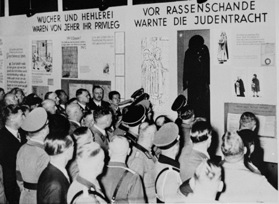
On June 23, 1944, one of the worst charades in history occurred: the Red Cross visited Thereisienstadt, a concentration camp in Czechoslovakia. According to the testimony of survivors, it was not the only such visit, but as you will see, we have pictures and records of that day. First, however, read the testimony of Mordechai Ansbacher, a survivor and witness:
“Whenever the visitors arrived. . . the whole ghetto would be turned upside down. Certain areas were under absolute curfew, and people living there had to remain indoors because their appearance would be too unsightly. Generally, only those who still preserved a more or less human appearance were allowed to move about outside. A beautification process would be on. Places had to be cleaned and made ship-shape. Houses were painted on the outside and large signboards put up saying, “Central Synagogue,” “Ghetto Theatre,” “Children’s School.”
“They even prepared teams of children in uniforms as if for soccer games. They had a children’s club for such occasions. Ice skating was installed, and ponies were brought in. Children were put into small beds with engraved hearts on the bed, as though in a veritable palace. Rehearsals were held with the children, and they were given food, which the children unfortunately ferociously devoured. They therefore had to repeat the rehearsals because we kept sending them new children each time to get food, so that as many as possible would eat well at least once.”[1]
Listen to the sadism involved here:
“To keep up the pretense and make a profit on the side, the Gestapo would sell prospective deportees apartment condominiums in Thereisenstadt. The newcomers arrived brandishing titled documents, but they were fortunate if they were allocated a plank in an attic of an old fort or a piece of floor in an army hut.” [2]

But in spite of all that, the charade worked. Here is the Red Cross report, prepared by Dr. Norbert Masur:
“Thereisienstadt is not a camp in the ordinary sense of the word, but a town inhabited by Jews and governed by them, in which every manner of work is to be done. This type of camp was designed by me and by my old friend Heidrich and was as we intended all camps to be.” [3]
And perhaps the bitterest irony of all is that Thereisienstadt really was the “best” camp, the one with the best survival rate. And perhaps without that charade and the report that resulted from it, something more might have been done to ease the worst crime against humanity in all of history.
[1] Gideon Hausner, Justice in Jerusalem, p. 158
[2] Ibid.
[3] Ibid., p. 159











